Part of a series of articles titled Yellowstone Science - Volume 26 Issue 1: Archeology in Yellowstone.
Article
Shorts (YS 26-1)
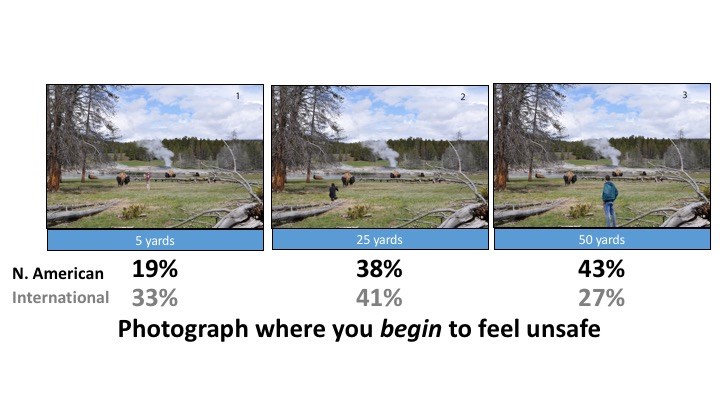
Communicating with International and North American Visitors about Bison Safety
by Zachary D. Miller, Wayne Freimund, & Tami Blackford
Wildlife viewing is one of the primary motivations for visiting national parks (Manfredo 2008), and visitors come from all over the world to experience the abundant wildlife viewing opportunities of Yellowstone National Park (YNP). However, free-roaming wildlife coupled with record levels of visitation means that human-wildlife conflicts are bound to happen. For instance, in the summer of 2014, five visitors were gored by bison. To address human-wildlife issues, park managers often rely on communication (i.e., interpretation and education) with visitors. Recent human-wildlife incidents illustrate that it is more important than ever that communication sources are effective in reaching park visitors and encouraging them to adopt appropriate behaviors around wildlife.
Yet visitation in YNP is not just growing, it is also changing. In particular, international visitation is making up a larger proportion of YNP visitors. Very little research has considered international visitor experiences in YNP. The research that does exist explores some of the differences among North American (from the U.S. and Canada) and international visitors regarding communication preferences and perceptions about safety while viewing bison (Miller, Freimund, and Blackford 2018).
Researchers from the University of Montana contacted over 1,000 visitors in the Old Faithful and Hayden Valley areas of YNP during the summer of 2015 (Miller, Freimund, and Blackford 2018). Of the visitors who spoke English well enough to engage (94.3%), 890 agreed to participate (response rate = 85%). North American visitors were about 85% of the sample. International visitors represented every continent except Antarctica. The most frequent non-North American countries of residence were Germany (2.9%), China (1.9%), The Netherlands (1.9%), and The United Kingdom (1.9%).
When viewed collectively, North American and international visitors were using information sources (i.e., signs, map/brochure, newspaper) in almost the exact same ways. North American and international visitors used about the same number of information sources (2.3 and 2.4 on average, respectively). Additionally, both groups used information sources at about the same rates. Lastly, there was no practical difference between North American and international visitors in how helpful they found the information sources.
This research also explored perceptions about safety while viewing bison. Visitors viewed three images and selected one of the images to answer the question, “Which of the following images best shows the distance where you would begin to feel unsafe viewing bison from?” (figure 1). There were significant differences between North American and international visitors. In general, international visitors chose the images that represented closer distances between visitors and bison. For instance, 14% more international visitors chose the image representing 5 yards between the bison and visitor as the distance they would begin to feel unsafe while viewing bison.
Results from this research indicate that although North American and international visitors were using information sources in the same ways, there were significant differences between the groups regarding perceptions about safety while viewing bison. International visitors tended to begin to feel unsafe at closer distances to bison than did North American visitors. If these beliefs lead to visitors actually getting closer to bison in YNP, it presents a safety issue for managers, visitors, and wildlife. Thus, park managers may need to specifically improve communications with international visitors about bison-visitor interactions.
However, there was a substantial proportion (18.9%) of North American visitors who also indicated they did not begin to feel unsafe viewing bison until they were at a distance of 5 yards from the bison, far closer than the recommended 25-yard distance. Although international visitors may be of particular concern due to unique language barriers and cultural differences, from a practical point of view, communications about viewing bison in YNP need to be improved for all visitors.
One approach to improving communications would be to promote information sources visitors rated as more helpful. Some of the most used information sources in YNP were rated as less helpful than other information sources. Park managers may want to direct visitors to the information sources that were rated the most helpful, which include educational groups, personal communication with rangers/employees, and interpretive programs. Additionally, because the most helpful information sources were all face-to-face forms of communication (not digital or print), providing more opportunities for these types of contact may also prove useful.
Another approach would be to include additional information in communication resources. For instance, international visitors may have less of an embedded idea about what wilderness/wildness is or may have different perspectives about national parks from previous visits to parks in other countries. This presents an excellent opportunity for YNP managers to tell the unique story of national parks, and how and why the national parks differ from other protected areas people may have visited. Including this type of information may encourage visitors to behave in more appropriate ways around wildlife.
Lastly, it is important to recognize that the “why” messages (i.e., bison are dangerous, respect bison’s space) are just as (or more) important than the “what” messages (stay 25 yards away from bison) in motivating visitors to adopt appropriate behaviors. People need reasons to care. Social theories, such as the theory of planned behavior (Ajzen 1991) may help inform this process. Incorporating content about attitudes, subjective norms, and perceived behavioral sources would potentially make information sources more effective in persuading visitors to adopt appropriate behaviors around bison and other wildlife. By motivating visitors with messages that are important and relevant, it becomes more likely that they will adopt appropriate behaviors (Petty and Cacioppo 1986).
Literature Cited
Ajzen, I. 1991. The theory of planned behavior. Organizational Behavior and Human Decision Processes 50:179–211.
Manfredo, M.J. 2008. Who cares about wildlife? Social Science concepts for exploring human-wildlife relationships and conservation issues. Spring Science & Business Media, LLC, New York, New York, USA.
Miller, Z.M., W.A. Freimund, and T. Blackford. 2018. Communication perspectives about bison safety in Yellowstone National Park: a comparison of international and North American visitors. Journal of Park & Recreation Administration 36(1): 178-186. 36,1: 178-186.
Petty, R.E., and J.T. Cacioppo. 1986. The elaboration likelihood model of persuasion. Pages 123-205 in L. Berkowitz, editor. Advances In experimental social psychology. Academic Press, New York, New York, USA.
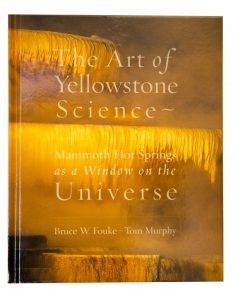
The Art of Yellowstone Science: Mammoth Hot Springs as a Window on the Universe
By Bruce W. Fouke and Tom Murphy, Crystal Creek Press, 300 pages
Book Review by Christie L. Hendrix
Some of the most fascinating things in our universe are more complex and beautiful than what initially meets the eye. The Art of Yellowstone Science pairs together renowned geobiologist Bruce Fouke and celebrated Rocky Mountain photographer Tom Murphy to provide a stunning written and visual account of Yellowstone National Park’s Mammoth Hot Springs. This book is about the intersection of science and art, and how they both arise from a desire to observe and learn. The authors argue that the two disciplines are not mutually exclusive and work in harmony as we study the natural world.
The authors present Mammoth Hot Springs as a case study where science and art are interconnected, and where gaining insights about other geothermal systems is possible. They state, “Mammoth is a place to see powerful and important connections between deep time and human experience, among geology, microbiology, physics, and chemistry, as well as between the sciences and the arts.” The authors acknowledge that recent scientific advancements, as well as innovations in photography and photo processing, have increased our understanding of the Mammoth Hot Springs area and made this book possible.
While Yellowstone has many geothermal systems, Mammoth Hot Springs is distinct from the others. It falls outside of the Yellowstone Caldera and is found on a limestone rock deposit. As the limestone is superheated by 100°C water, it permeates the subsurface and deposits as travertine in a layer cake-like quality on the landscape. This expansive limestone system is uncommon, found only in a few locations around the globe. Mammoth Hot Springs is the second largest active deposit in the world (the largest located in Turkey). With deposition rates as high as 5 millimeters per day, the area allows scientists to complete full studies within short periods of time. Mammoth is also rare in that the system has been preserved in its natural state, with little human influence, making it more valuable for scientific study and more enjoyable for visitors seeking untrammeled beauty.
The authors remind us that “scientists and artists love surprises.” Our tendency to visually observe unique forms in nature and become inquisitive is what draws people to Mammoth Hot Springs. The intricate patterns of the terraces and surrounding vegetation, the steam rising, the colors present in the terracettes lead the human mind to wonder, “How did this occur?” The book explains in detail how we have learned, through science and the visual arts, the inner workings of the Mammoth Hot Springs system.
Throughout the pages of this book, the authors provide thoughtful narratives juxtaposed with stunning photographic examples of the systems and concepts described. The book covers not only the current research efforts in Mammoth, but its geologic history, recent advancements in microbial taxonomy, and Mammoth’s historical use by explorers and visitors. The images include traditional stills of nature, as well as aerial photography, and infrared and microscopy imagery. Fouke deftly explains challenging scientific processes in a relatable manner. Murphy also doesn’t disappoint—his photos range from beautiful landscapes to fine-scale, detailed macros, making the reader’s brain yearn to learn about the Mammoth Hot Springs system and to visit it in person. There are even a few photos of charismatic megafauna taking respite in the thermal areas.
This book is a culmination of years of observation, on the part of both a research scientist and an artist. It is not just a thesis on scientific inquiry with photo accompaniment; it is truly a marriage of essay and art that works as one to provide a valuable “window on the universe” of Mammoth Hot Springs. The book is available in both hard cover and digital format from Crystal Creek Press (http://www.artofyellowstonescience.com/).
Recovery of Soda Butte Creek, Post-Reclamation
by Andrew Ray, Tom Henderson, Pete Penoyer, Autumn Coleman, & Kristin Legg
Nearly 25 years ago, researchers described a layer of unusual bright orange-red sediments on the floodplains of the lower reaches of Soda Butte Creek, just upstream of the confluence with the Lamar River inside Yellowstone National Park (YNP; Meyer 1993, Marcus et al. 2001). These conspicuously colored sediments were traced nearly 15 miles (23 km) upstream and outside YNP to the abandoned McLaren Mill and Tailings Impoundment located near Cooke City, Montana. The McLaren Mill processed material from the McLaren Gold Mine in the New World District. Abandoned in the 1950s, the mill was gone but the failing tailings impoundment plugged Soda Butte Creek. Sediments immediately downstream of the McLaren Mill and Tailings site (McLaren site hereafter) were not only rust colored (figure 1), they were enriched with heavy metals, including iron, copper, lead, arsenic, and zinc (Marcus et al. 2001). Iron levels from tailings sediments were 2-10 times higher, and copper levels were 1-2 orders of magnitude (10-100 times) higher than the background stream sediment levels (Meyer 1993, Marcus et al. 2001). Additionally, concentrations of iron in water sampled from Soda Butte Creek below the McLaren site were 25 times higher than waters upstream of the tailings site (Boughton 2001). Iron-rich orange waters seeping from the base of the tailings impoundment were shown to be toxic to fish and zooplankton, causing 100% mortality within 24 hours of exposure (Nimmo et al. 1998). Stream insect community diversity was also dramatically reduced downstream of the former mine and tailings site, relative to upstream, unimpaired reaches of Soda Butte Creek (Marcus et al. 2001).
Tailings on the McLaren site bordering Soda Butte Creek near the town of Cooke City were identified as a significant anthropogenic source disproportionately contributing to Soda Butte Creek’s impairment (Nimmo et al. 1998, Boughton 2001, Marcus et al. 2001, MTDEQ 2002). The segment of Soda Butte Creek below the McLaren site and downstream to the Montana-Wyoming border was first listed in 1996 as an impaired water body, under Section 303(d) of the Clean Water Act (MTDEQ 1996). Today, it represents the only Clean Water Act-impaired water body entering YNP (O’Ney et al. 2016). Montana Department of Environmental Quality’s (MTDEQ) list of impaired waters identifies four metals (copper, iron, lead, and manganese) as the causes of water quality impairment in Soda Butte Creek (MTDEQ 2017).
In 2014, the MTDEQ Abandoned Mine Lands Program completed the McLaren Tailings Reclamation Project, culminating five years of reclamation work. This reclamation effort required excavating approximately one half million tons (equal to one billion pounds) of contaminated tailings, pumping and treating of over 100 million gallons (0.4 million m3) of contaminated water, and reconstructing approximately 1,800 ft. (550 m) of Soda Butte Creek and Miller Creek stream channels. Importantly, this work removed the potentially unstable tailings impoundment, moderated the metal loading, improved downstream water quality, and enhanced the ecological condition of Soda Butte Creek (Henderson et al. 2018). In 2015, National Park Service (NPS) and MTDEQ scientists initiated studies in Soda Butte Creek to document water quality immediately downstream of the reclaimed tailings site (station SBC2; USFS 1999) to mirror the previous water quality studies begun a decade (2000-2010) prior to reclamation (USFS 2012).
Water quality results from monitoring station SBC-2, immediately downstream of the McLaren site and just east of Cooke City, show that exceedances (i.e., exceeding the MTDEQ water quality standard) for iron (figure 2a) and copper occurred annually from 2000 to 2010. During this period, iron exceeded the MTDEQ standard of 1.0 mg/L in 20 of the 31 samples (65%) collected. Iron concentrations were shown to be strongly related with river flows (r = -0.768, p < 0.001, N = 30); high iron levels and associated exceedances generally occurred during low flow conditions (figure 2a). Low flow water quality exceedances suggest that contaminated waters from the McLaren site disproportionately contributed to metal loading during base or low flows. In contrast, snowmelt runoff or tributaries’ inputs during high flows acted to dilute mine-related metal loading. From the 11 water samples collected between June 2015 and June 2016 and following the completion of reclamation activities, no exceedances of iron were documented immediately downstream from the McLaren site (figure 2b). While all of the 11 post-reclamation water samples showed low levels of total iron (average = 0.08 mg/L, range = 0.02 to 0.18 mg/L), iron levels are now lowest during low flows and increase modestly with increased flow levels. This latter finding supports the claim that the primary anthropogenic source of iron pollution to Soda Butte Creek (i.e., contaminated inflows from the McLaren tailings impoundment; Boughton 2001) have been successfully addressed.
Prior to reclamation activities, copper exceeded the MTDEQ hardness-based water quality standard less frequently than iron; however, copper exceedances occurred in 8 of the 31 samples (26%) and typically during high flows. In contrast, only one copper exceedance was documented in 2015 and 2016 following reclamation. Elevated copper levels have long been detected in Miller Creek (Furniss et al. 1999, Hren et al. 2001), a tributary that discharges into Soda Butte Creek in the middle of the McLaren site from the north and above the SBC-2 sampling site. It is shown that during high flow, approximately one half to two thirds of the copper load measured at SBC-2 can be attributed to Miller Creek.
Prior to reclamation, manganese concentrations exceeded the U.S. Environmental Protection Agency’s National Secondary Maximum Contaminant Level (SMCL) in 14 of the 31 samples (45%) collected from 2000 through 2010. None of the 11 post-reclamation samples contained manganese above the SMCL. There were no documented lead exceedances below the McLaren site before or following reclamation activities.
The bright orange stream sediments that conspicuously marked the contamination in Soda Butte Creek prior to reclamation are gone (figure 3). These changes are a striking visual indicator of the improvements in ecological condition credited to the reclamation of the McLaren site. Improvements in water quality have been carefully documented (Henderson et al. 2018) and facilitated the return of beneficial uses, such as fishing. The collaboration between the MTDEQ and NPS was critical to the planning and execution of the McLaren Tailings Reclamation Project. This collaboration also made possible the post-reclamation characterization of water quality in upper Soda Butte Creek watershed. Project data quantifies water quality improvements and supports a formal assessment of post-reclamation water quality of this 303(d)-listed stream. Importantly, the data collected in Soda Butte Creek supports the preliminary decision by MTDEQ to recommend that Soda Butte Creek, from the McLaren site to the YNP boundary, be delisted for all metals, the first such recommendation in Montana. The reclamation and subsequent delisting represent major milestones to Yellowstone National Park. In addition, the water quality improvements and the removal of contaminated source materials will support Yellowstone native cutthroat trout (Oncorhynchus clarkii bouvieri) conservation efforts (MTFWP 2015), and safeguard downstream aquatic and riparian habitats from the legacy of mining in this region.
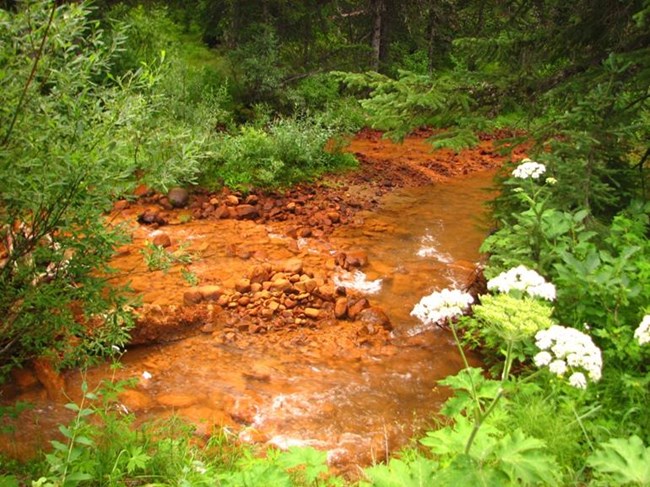
NPS Photo - A. Ray
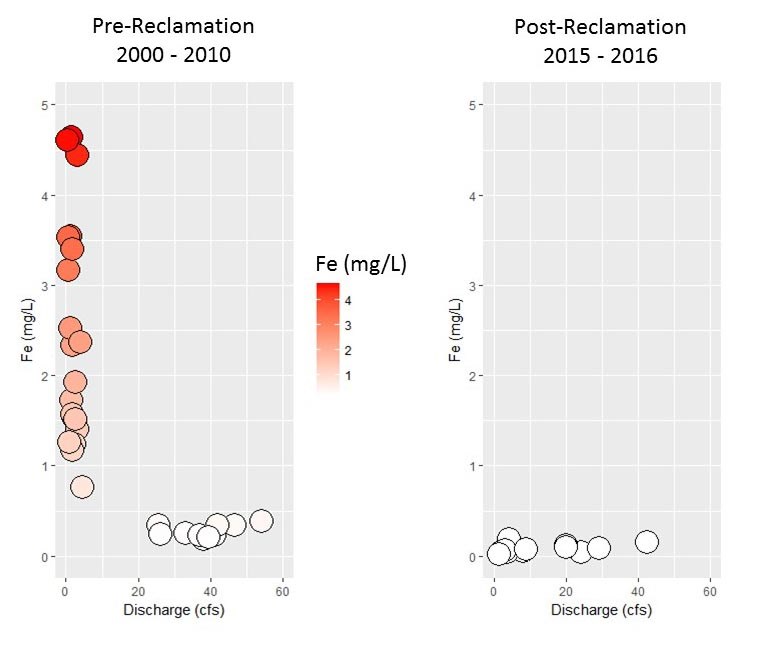
Samples that meet the MTDEQ iron standard are shown in white; those that exceed the standard are shown in shades of red. The window of reclamation extended from summer of 2010 to fall of 2014.
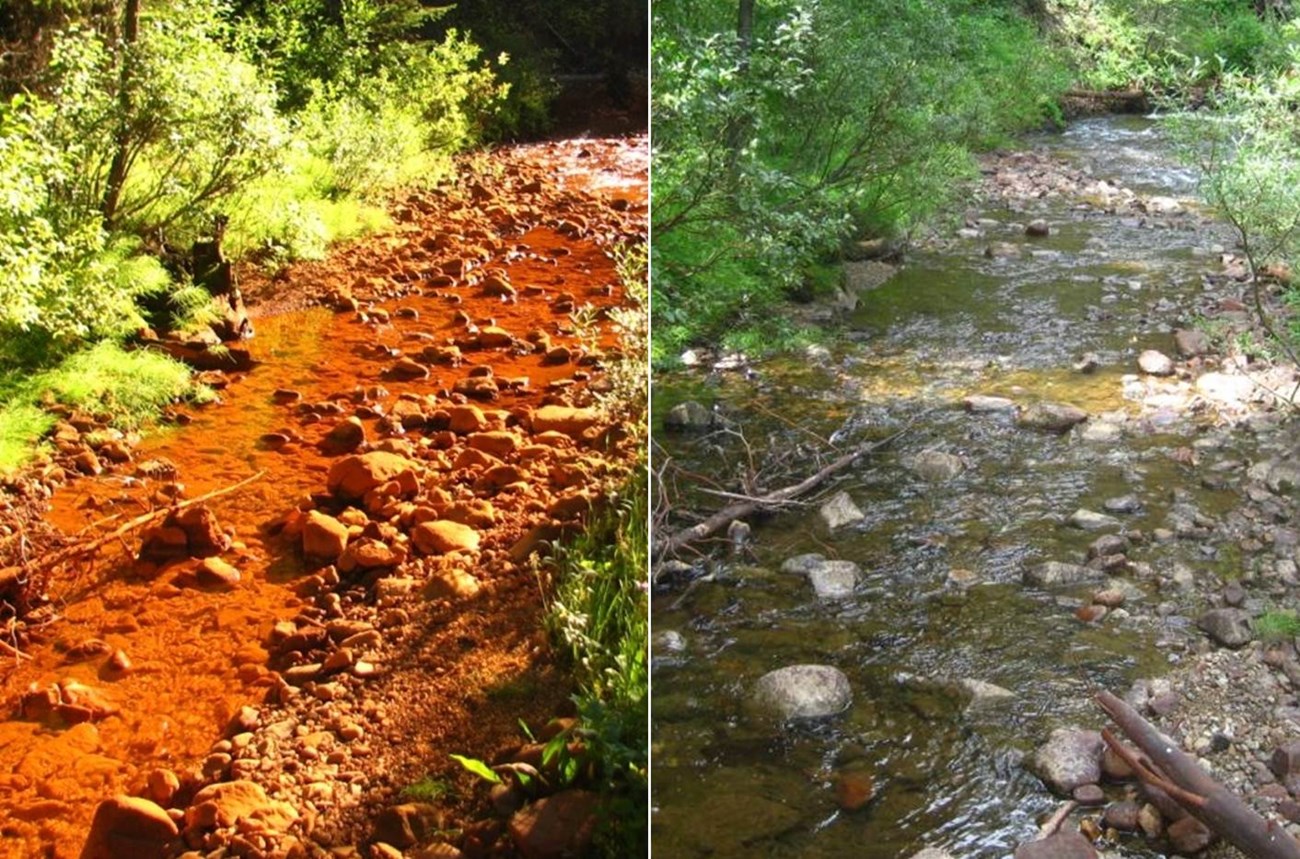
NPS Photo - A. Ray
Literature Cited
Boughton, G. K. 2001. Metal loading in Soda Butte Creek upstream of Yellowstone National Park, Montana and Wyoming: a retrospective analysis of previous research; and quantification of metal loading, August 1999. Water Resources Investigations Report 01-4170, U.S. Geological Survey, Cheyenne, Wyoming, USA.
Furniss, G., N.W. Hinman, G.A. Doyle, and D.D. Runnells. 1999. Radio carbon-dated ferricrete provides a record of natural acid rock drainage and paleoclimatic changes. Environmental Geology 37:102-106.
Henderson, T., A. Ray, P. Penoyer, A. Rodman, M. Levandowski, A. Yoder, S. Matolyak, M.B. Marks, and A. Coleman. 2018. Mine-tailings reclamation project improves water quality in Yellowstone’s Soda Butte Creek. Park Science 34:9-21.
Hren, M., C. Chamberlain, and F. Magilligan. 2001. A combined flood surface and geochemical analysis of metal fluxes in in a historically mind region: a case study from the New World Mining District, Montana. Environmental Geology 40:1334-1346.
Marcus, W. A., G. A. Meyer, and D. R. Nimmo. 2001. Geomorphic control of persistent mine impacts in a Yellowstone Park stream and implications for the recovery of fluvial systems. Geology 29:355-358.
Meyer, G. 1993. A polluted flash flood and its consequences. Yellowstone Science 2:2-6.
Montana Department of Environmental Quality (MTDEQ). 1996. Montana list of waterbodies in need of total maximum daily load development. MTDEQ, Helena, Montana, USA.
Montana Department of Environmental Quality (MTDEQ). 2002. Water quality restoration plan for the Cooke City TMDL planning area. MTDEQ, Helena, Montana, USA.
Montana Department of Environmental Quality (MTDEQ). 2017. Montana final 2016 water quality integrated report. MTDEQ, Helena, Montana, USA.
Montana Fish, Wildlife and Parks (MTFWP). 2015. Soda Butte Creek Yellowstone Cutthroat Trout Conservation Project. Draft Environmental Assessment. MTFWP Region 5 Office, Billings, Montana, USA.
Nimmo, D. R., M. J. Willox, T. D. Lafrancois, P. L. Chapman, S. F. Brinkman and J. C. Greene. 1998. Effects of metal mining and milling on boundary waters of Yellowstone National Park, USA. Environmental Management 22:913-926.
O’Ney, S., J. Arnold, C. Bromely, C., K. Hershberger, and W.A. Sigler. 2016. Greater Yellowstone Network water quality monitoring annual report: January 2009–December 2009. Natural Resource Data Series. NPS/GRYN/NRDS—2011/310. National Park Service, Natural Resource Stewardship and Science. Fort Collins, Colorado, USA.
U.S. Forest Service. 1999. Long-term surface water quality monitoring plan, New World Mining District Response and Restoration Project. Maxim Technologies, Inc., Helena, Montana, USA.
U.S. Forest Service. 2012. New World Project long-term operations and maintenance plan, New World Mining District Response and Restoration Project. Tetra Tech, Bozeman, Montana, USA.
Last updated: April 10, 2019
